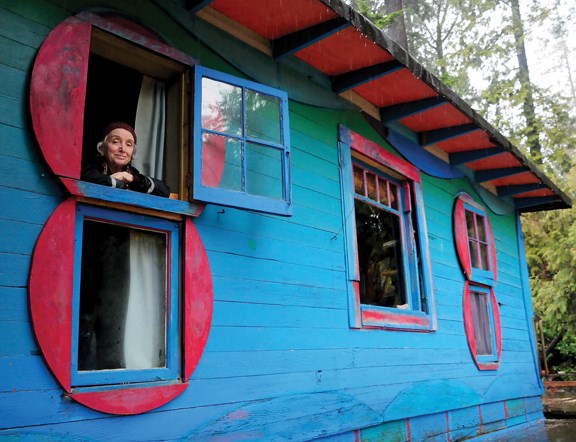For decades, renowned Canadian artists Al Neil and Carole Itter have considered the little blue beach cabin near to Cates Park both a refuge and a source of artistic inspiration.
Nestled among cedar trees and salal near the water’s edge, the tongue and groove cabin built on pilings seems almost to drift on tidal currents, its window like portholes gazing out to the mist on the inlet.
Neil, an experimental multimedia artist and freestyle jazz musician, composed music on the Farrand upright piano that still stands in the cabin.
He first moved there in 1966, and was there when the North Vancouver waterfront was dotted with squatters’ shacks and a counterculture community of artists and hippies thrived along the Dollarton waterfront.
But now, the cabin that is the last remaining piece of that era is being threatened with demolition.
In November, Port Metro Vancouver which owns the land the cabin sits on, issued the couple with an eviction notice, telling them the cabin must be removed by Jan. 31.
Events were set in motion after the McKenzie Barge site immediately adjacent to the cabin was sold to the Polygon development company, which plans to build a condo project on the old industrial site.
The cabin has to go, said port authorities, so that a habitat restoration project on the foreshore, being done in conjunction with an environmental clean-up of that site, can proceed.
Pollutants including arsenic, lead, mercury and hydrocarbons from decades of industrial use have been found in the soil of the nearby foreshore.
Neil, now 90, and Itter, 75, have been shaken by the eviction.
“The stress has been hard on my health,” said Itter.
Although they don’t live in the cabin year-round (they also have a home in a Strathcona housing co-op) it’s been a retreat for the couple for many decades, ever since Neil moved into the cabin as a sort of informal watchman for the barge company.
“I think for both Al and I, it’s provided everything from a refuge to a place of wonderful inspiration,” said Itter. “It’s informed our art in every way.”
Now a group of younger artists has stepped forward with an appeal to save the cabin.
“This truly is the last vestige of what was a profound part of history on that shoreline,” said Esther Rausenberg, executive director of the East Side Cultural Crawl, and one of those working to save the cabin. “Once you take that down, you cannot bring that back.”
According to a report on the cabin’s cultural significance prepared by North Vancouver Museum and Archives director Nancy Kirkpatrick, during the 1930s and 40s, the shores of Burrard Inlet were home to about 1,000 people living in houseboats and foreshore cottages in squatter communities. The writer Malcolm Lowry was one of those who famously lived along the Dollarton waterfront.
Most of the squatter cabins were destroyed in the 1950s. But in the early 1970s, another counter-culture community of artists flourished on the Maplewood mudflats and adjacent areas. Itter and Neil’s blue cabin is the last of those remaining.
“Now that way of life is completely gone,” said Kirkpatrick.
When the District of North Vancouver learned of the situation last fall, it looked at options including the possibility of moving the cabin or saving its façade.
But once district staff looked at the cabin, they concluded moving it to a new location would likely cost at least $60,000, said David Stuart, chief administrative officer for the municipality.
If the district wanted to use the cabin, it would cost even more to bring it up to current Building Code standards.
“If we were to move the shack where would we move it to and what we do with it?” said Stuart.
Glenn Alteen, a director of the Grunt Gallery, is one of the artists who still hopes to save the cabin. Alteen said the goal right now is to find a place the cabin could be stored temporarily while a more permanent use or location is pursued.
“At this point we’re just trying to save it.”
John Parker-Jervis, spokesman for Port Metro Vancouver, said the port has been “sympathetic to the impact (removal of the cabin) will have on the artists…We do appreciate the history.”
He added authorities would also consider the possibility of extending the eviction deadline if requested.
So far, Itter has been slowly removing some of the couple’s possessions with the help of a friend who has a 12-foot rowboat. “That’s how an awful lot of stuff came in,” she said.
Itter said she and Neil likely won’t be involved in the future of the cabin, even if it is saved. “We’ve given it up,” she said.



